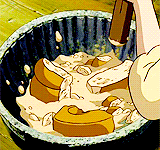Yerres, Path Through The Old Growth Woods In The Park Via Gustave Caillebotte

Yerres, Path Through the Old Growth Woods in the Park via Gustave Caillebotte
Size: 43x31 cm Medium: oil on canvas
More Posts from Smparticle2 and Others






Sleeping brain's complex activity mimicked by simple model
Researchers have built and tested a new mathematical model that successfully reproduces complex brain activity during deep sleep, according to a study published in PLOS Computational Biology.

Recent research has shown that certain patterns of neuronal activity during deep sleep may play an important role in memory consolidation. Michael Schellenberger Costa and Arne Weigenand of the University of Lübeck, Germany, and colleagues set out to build a computational model that could accurately mimic these patterns.
The researchers had previously modeled the activity of the sleeping cortex, the brain’s outer layer. However, sleep patterns thought to aid memory arise from interactions between the cortex and the thalamus, a central brain structure. The new model incorporates this thalamocortical coupling, enabling it to successfully mimic memory-related sleep patterns.
Using data from a human sleep study, the researchers confirmed that their new model accurately reproduces brain activity measured by electroencephalography (EEG) during the second and third stages of non-rapid eye movement (NREM) sleep. It also successfully predicts the EEG effects of stimulation techniques known to enhance memory consolidation during sleep.
The new model is a neural mass model, meaning that it approximates and scales up the behavior of a small group of neurons in order to describe a large number of neurons. Compared with other sleep models, many of which are based on the activity of individual neurons, this new model is relatively simple and could aid in future studies of memory consolidation.
“It is fascinating to see that a model incorporating only a few key mechanisms is sufficient to reproduce the complex brain rhythms observed during sleep,” say senior authors Thomas Martinetz and Jens Christian Claussen.










Studio Ghibli + Food










(Image caption: Young neurons (pink), responsible for encoding new memories, must compete with mature neurons (green) to survive and integrate into the hippocampal circuit. Credit: Kathleen McAvoy, Sahay Lab)
Making memories stronger and more precise during aging
When it comes to the billions of neurons in your brain, what you see at birth is what get — except in the hippocampus. Buried deep underneath the folds of the cerebral cortex, neural stem cells in the hippocampus continue to generate new neurons, inciting a struggle between new and old as the new attempts to gain a foothold in the memory-forming center of the brain.
In a study published online in Neuron, Harvard Stem Cell Institute (HSCI) researchers at Massachusetts General Hospital and the Broad Institute of MIT and Harvard in collaboration with an international team of scientists found they could bias the competition in favor of the newly generated neurons.
“The hippocampus allows us to form new memories of ‘what, when and where’ that help us navigate our lives,” said HSCI Principal Faculty member and the study’s corresponding author, Amar Sahay, PhD, “and neurogenesis—the generation of new neurons from stem cells—is critical for keeping similar memories separate.”
As the human brain matures, the connections between older neurons become stronger, more numerous, and more intertwined, making integration for the newly formed neurons more difficult. Neural stem cells become less productive, leading to a decline in neurogenesis. With fewer new neurons to help sort memories, the aging brain can become less efficient at keeping separate and faithfully retrieving memories.
The research team selectively overexpressed a transcription factor, Klf9, only in older neurons in mice, which eliminated more than one-fifth of their dendritic spines, increased the number of new neurons that integrated into the hippocampus circuitry by two-fold, and activated neural stem cells.
When the researchers returned the expression of Klf9 back to normal, the old dendritic spines reformed, restoring competition. However, the previously integrated neurons remained.
“Because we can do this reversibly, at any point in the animals life we can rejuvenate the hippocampus with extra, new, encoding units,” said Sahay, who is also an investigator with the MGH Center for Regenerative Medicine.
The authors employed a complementary strategy in which they deleted a protein important for dendritic spines, Rac1, only in the old neurons and achieved a similar outcome, increasing the survival of the new neurons.
In order to keep two similar memories separate, the hippocampus activates two different populations of neurons to encode each memory in a process called pattern separation. When there is overlap between these two populations, researchers believe it is more difficult for an individual to distinguish between two similar memories formed in two different contexts, to discriminate between a Sunday afternoon stroll through the woods from a patrol through enemy territory in a forest, for example. If the memories are encoded in overlapping populations of neurons, the hippocampus may inappropriately retrieve either. If the memories are encoded in non-overlapping populations of neurons, the hippocampus stores them separately and retrieves them only when appropriate.
Mice with increased neurogenesis had less overlap between the two populations of neurons and had more precise and stronger memories, which, according to Sahay, demonstrates improved pattern separation.
Mice with increased neurogenesis in middle age and aging cohorts exhibited better memory precision.
“We believe that by increasing the hippocampus’s ability to do what it supposed to do and not retrieve past experiences when it shouldn’t can help,” Sahay said. This may be particularly useful for individuals suffering from post-traumatic stress disorder, mild cognitive impairment, or age-related memory loss.

How to Make a Motor Neuron
A team of scientists has uncovered details of the cellular mechanisms that control the direct programming of stem cells into motor neurons. The scientists analyzed changes that occur in the cells over the course of the reprogramming process. They discovered a dynamic, multi-step process in which multiple independent changes eventually converge to change the stem cells into motor neurons.
“There is a lot of interest in generating motor neurons to study basic developmental processes as well as human diseases like ALS and spinal muscular atrophy,” said Shaun Mahony, assistant professor of biochemistry and molecular biology at Penn State and one of the lead authors of the paper. “By detailing the mechanisms underlying the direct programing of motor neurons from stem cells, our study not only informs the study of motor neuron development and its associated diseases, but also informs our understanding of the direct programming process and may help with the development of techniques to generate other cell types.”
The direct programming technique could eventually be used to regenerate missing or damaged cells by converting other cell types into the missing one. The research findings, which appear online in the journal Cell Stem Cell on December 8, 2016, show the challenges facing current cell-replacement technology, but they also outline a potential pathway to the creation of more viable methods.
“Despite having a great therapeutic potential, direct programming is generally inefficient and doesn’t fully take into account molecular complexity,” said Esteban Mazzoni, an assistant professor in New York University’s Department of Biology and one of the lead authors of the study. “However, our findings point to possible new avenues for enhanced gene-therapy methods.”
The researchers had shown previously that they can transform mouse embryonic stem cells into motor neurons by expressing three transcription factors – genes that control the expression of other genes – in the stem cells. The transformation takes about two days. In order to better understand the cellular and genetic mechanisms responsible for the transformation, the researchers analyzed how the transcription factors bound to the genome, changes in gene expression, and modifications to chromatin at 6-hour intervals during the transformation.
“We have a very efficient system in which we can transform stem cells into motor neurons with something like a 90 to 95 percent success rate by adding the cocktail of transcription factors,” said Mahony. “Because of that efficiency, we were able to use our system to tease out the details of what actually happens in the cell during this transformation.”
“A cell in an embryo develops by passing through several intermediate stages,” noted Uwe Ohler, senior researcher at the Max Delbrück Center for Molecular Medicine (MDC) in Berlin and one of the lead authors of the work. “But in direct programming we don’t have that: we replace the gene transcription network of the cell with a completely new one at once, without the progression through intermediate stages. We asked, what are the timing and kinetics of chromatin changes and transcription events that directly lead to the final cell fate?“
The research team found surprising complexity – programming of these stem cells into neurons is the result of two independent transcriptional processes that eventually converge. Early on in the process, two of the transcription factors – Isl1 and Lhx3 – work in tandem, binding to the genome and beginning a cascade of events including changes to chromatin structure and gene expression in the cells. The third transcription factor, Ngn2, acts independently making additional changes to gene expression. Later in the transformation process, Isl1 and Lhx3 rely on changes in the cell initiated by Ngn2 to help complete the transformation. In order for direct programming to successfully achieve cellular conversion, it must coordinate the activity of the two processes.
“Many have found direct programming to be a potentially attractive method as it can be performed either in vitro – outside of a living organism – or in vivo – inside the body and, importantly, at the site of cellular damage,” said Mazzoni. “However, questions remain about its viability to repair cells – especially given the complex nature of the biological process. Looking ahead, we think it’s reasonable to use this newly gained knowledge to, for instance, manipulate cells in the spinal cord to replace the neurons required for voluntary movement that are destroyed by afflictions such as ALS.”

Pleasantville (1998)

Hold a buoyant sphere like a ping pong ball underwater and let it go, and you’ll find that the ball pops up out of the water. Intuitively, you would think that letting the ball go from a lower depth would make it pop up higher – after all, it has a greater distance to accelerate over, right? But it turns out that the highest jumps comes from balls that rise the shortest distance. When released at greater depths, the buoyant sphere follows a path that swerves from side to side. This oscillating path is the result of vortices being shed off the ball, first on one side and then the other. (Image and research credit: T. Truscott et al.)
-
 eunych-born-eunych reblogged this · 8 years ago
eunych-born-eunych reblogged this · 8 years ago -
 smparticle2 reblogged this · 8 years ago
smparticle2 reblogged this · 8 years ago -
 dianne56 liked this · 8 years ago
dianne56 liked this · 8 years ago -
 toofrops reblogged this · 8 years ago
toofrops reblogged this · 8 years ago -
 ibrethhere liked this · 8 years ago
ibrethhere liked this · 8 years ago -
 laguidart liked this · 8 years ago
laguidart liked this · 8 years ago -
 eunych-born-eunych liked this · 8 years ago
eunych-born-eunych liked this · 8 years ago -
 rosehovick reblogged this · 8 years ago
rosehovick reblogged this · 8 years ago -
 torsmindpalace liked this · 8 years ago
torsmindpalace liked this · 8 years ago -
 eloyfcalleja liked this · 8 years ago
eloyfcalleja liked this · 8 years ago -
 ohappylivingthings liked this · 8 years ago
ohappylivingthings liked this · 8 years ago -
 erindotburr reblogged this · 8 years ago
erindotburr reblogged this · 8 years ago -
 megasuetposts liked this · 8 years ago
megasuetposts liked this · 8 years ago -
 fotografulcreativ-blog liked this · 8 years ago
fotografulcreativ-blog liked this · 8 years ago -
 beyondlimitations88 liked this · 8 years ago
beyondlimitations88 liked this · 8 years ago -
 freewor liked this · 8 years ago
freewor liked this · 8 years ago -
 marko-man liked this · 8 years ago
marko-man liked this · 8 years ago -
 rodenaumisljena reblogged this · 8 years ago
rodenaumisljena reblogged this · 8 years ago -
 rodenaumisljena liked this · 8 years ago
rodenaumisljena liked this · 8 years ago -
 mynakedlunch reblogged this · 8 years ago
mynakedlunch reblogged this · 8 years ago -
 mynakedlunch liked this · 8 years ago
mynakedlunch liked this · 8 years ago -
 jbgravereaux reblogged this · 8 years ago
jbgravereaux reblogged this · 8 years ago -
 jbgravereaux liked this · 8 years ago
jbgravereaux liked this · 8 years ago -
 recccklesss liked this · 8 years ago
recccklesss liked this · 8 years ago -
 artist-degas reblogged this · 8 years ago
artist-degas reblogged this · 8 years ago -
 janneke43 liked this · 8 years ago
janneke43 liked this · 8 years ago -
 learnarthistory liked this · 8 years ago
learnarthistory liked this · 8 years ago -
 goddess-of-dichotomies liked this · 8 years ago
goddess-of-dichotomies liked this · 8 years ago -
 jojajije liked this · 8 years ago
jojajije liked this · 8 years ago -
 3bbs-and-flowz liked this · 8 years ago
3bbs-and-flowz liked this · 8 years ago -
 rumble-in-the-concrete-jungle liked this · 8 years ago
rumble-in-the-concrete-jungle liked this · 8 years ago